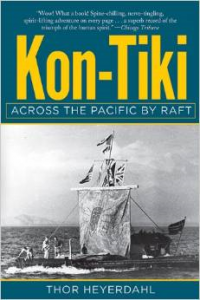 Veteran WoWasis readers are aware of our penchant for reviewing books on Asia and the Pacific, especially older classics. Why? For one thing, younger readers may have missed them. And Boomers and Gen Xers might not have read them either, although they’ve certainly heard of them. Thor Heyerdahl’s Kon-Tiki: Across the Pacific by Raft is certainly one of these. The voyage, made in 1947, is famous and iconic. It spawned “Tiki Culture” across the United States and much of the world: every Tiki bar in the world owes something to the book that made the word “Tiki” famous. But what of the amazing voyage itself? Heyerdahl’s tale, read more than six decades after it was published, remains an amazing one. The story is a timeless one, and begs to be read today.
Veteran WoWasis readers are aware of our penchant for reviewing books on Asia and the Pacific, especially older classics. Why? For one thing, younger readers may have missed them. And Boomers and Gen Xers might not have read them either, although they’ve certainly heard of them. Thor Heyerdahl’s Kon-Tiki: Across the Pacific by Raft is certainly one of these. The voyage, made in 1947, is famous and iconic. It spawned “Tiki Culture” across the United States and much of the world: every Tiki bar in the world owes something to the book that made the word “Tiki” famous. But what of the amazing voyage itself? Heyerdahl’s tale, read more than six decades after it was published, remains an amazing one. The story is a timeless one, and begs to be read today.
When Heyerdahl posited that distant Pacific islands had been populated by ancient adventurers from present-day Peru, he was met by everything from scorn to disbelief. He decided to replicate the journey on a hand-built wooden raft, built as he supposed the legendary voyagers would have done it, with similar materials. It took 101 days for the six man crew to transverse 4300 nautical miles, to reach island Polynesia and worldwide acclaim.
The fascinating tale isn’t solely about the actual voyage, either. In luxurious prose, he tells of the arduous trek through South American forests to obtain the wood needed to build the craft:
We went on up over sun-smitten slopes without a bush or tree and down into valleys of desert sand and cactus, till finally we climbed up and reached the topmost crest with snow fields round the peak and a wind so bitingly cold that we had to slacken speed in order not to freeze to bits as we sat in our shirts longing for jungle heat. For long stretches we had to drive across country between the mountains, over scree and grassy ridges, searching for the next bit of road. But when we reached the west wall, where the Andes range falls precipitously to the lowlands, the mule track was cut along shelves in the loose rock, and sheer cliffs and gorges were all about us. We put all our trust in friend Agurto as he sat crouched over the steering wheel, always swinging out when we came to a precipice. Suddenly a violent gust of wind met us; we had reached the outermost crest of the Andes chain, where the mountain fell away sharply in a series of precipices to the jungle far down in a bottomless abyss 12,000 feet beneath us. But we were cheated of the dizzy view over the sea of jungle, for, as soon as we reached the edge, thick cloud banks rolled about us like steam from a witches’ cauldron. But now our road ran down unhindered into the depths. Always down, in steep loops along gorges and bluffs and ridges, while the air grew damper and warmer and ever fuller of the heavy, deadening hot-house air which rose from the jungle world below.
 The sea voyage was fraught with many dangers, many of which involved the ravages of sea and storms upon the raft. Seawater attacked radio gear and food. A plethora of ease creatures accompanied them at various times. Heyerdahl is a formidable wordsmith, leaving the reader at the edge of his or her seat, hoping, along with the crew, for a Polynesian island to emerge as a final destination. It was Raroia, in the Tuamotu Islands:
The sea voyage was fraught with many dangers, many of which involved the ravages of sea and storms upon the raft. Seawater attacked radio gear and food. A plethora of ease creatures accompanied them at various times. Heyerdahl is a formidable wordsmith, leaving the reader at the edge of his or her seat, hoping, along with the crew, for a Polynesian island to emerge as a final destination. It was Raroia, in the Tuamotu Islands:
As soon as we had become acquainted with the 127 inhabitants of the village, a long table was laid for the two chiefs and the six of us, and the village girls came round bearing the most delicious dishes. While some arranged the table, others came and hung plaited wreaths of flowers round our necks and smaller wreaths round our heads. These exhaled a lingering scent and were cool and refreshing in the heat. And so a feast of welcome began which did not end till we left the island weeks after. Our eyes opened wide
and our mouths watered, for the tables were loaded with roast suckling pigs, chickens, roast ducks, fresh lobsters, Polynesian fish dishes, breadfruit, papaya, and coconut milk. While we attacked the dishes, we were entertained by the crowd singing hula songs, while young girls danced round the table.
The book revels in anthropology, history, and nautical lore, a marvel of adventure that is timeless. It never fails to enchant, decades after it first appeared in print, a literary joy and a magnificent tribute to adventure. Buy this book now at the WoWasis eStore.
Leave a Reply